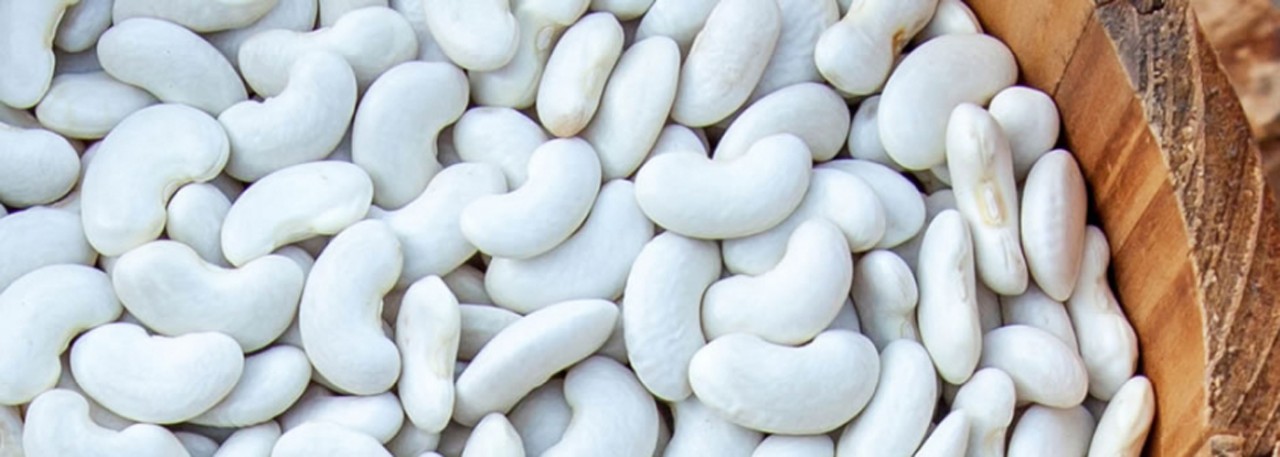.png.transform/rendition-xs/image_image%20(1).png)
Mongeta del Ganxet PDO
Seeds of the indigenous "ganxet" variety of Phaseolus vulgaris L. beans, dried or cooked and preserved, in the commercial category Extra.
Tasting notes
Slightly wrinkled and barely noticeable skin. Very creamy and with a characteristic mild flavor.
Other notes
“Ganxet” beans are a traditional variety of indeterminate growth; the plants have a climbing habit (type IV), white flowers with white, flat and markedly kidney-shaped beans (“ganxet” means little hook in Catalan).
Basic characteristics:
Morphological: The beans have a pronounced kidney shape and are hooked to a degree of 2 to 3 on a scale of 0 to 3 for the whole of the species Phaseolus vulgaris L. The beans are flattened, white and slightly glossy. Weight: 100 beans weigh aprox 50 g.
Chemical properties: the beans have a high protein content, 27% or more, and are low in starch, 25% or less, properties that are related to the high degree of creaminess of the end product. Moisture content is less than 15%.
Production / Processing method
The cycle is approximately one hundred and twenty days in duration. The pods are on average around 15 cm / 6 ins in length and normally contain about four seeds. Production of the protected beans is low compared to other climbing varieties grown in the area. In fact, within the variability shown by the varietal type there are genotype variations that give the more typically “Ganxet” forms (with a more pronounced hook) a higher percentage of protein, low starch content and lower production than the others.
In terms of cultivation, it is a herbaceous plant of indeterminate habit, needing a growing framework, usually consisting of canes, plastic mesh or poles. To prepare the soil, it is usually worked with a hoe or disc plow in order to bury the remains of the previous crop, followed by several passes with a cultivator to break down any lumps of soil. The process is sometimes rounded off with a soil grinder.
Sowing is normally done after cereal crops have been harvested, in mid-July. As the plant grows its water requirements increase rapidly and it is particularly sensitive to lack of water at the flowering stage.
The plants are normally cut at the base when they reach maturity and fifteen days before harvesting, to make drying easier. Harvesting is as mechanized as possible, although it is still a largely manual process. If plastic mesh is used as a growing framework, it must be collected together with the plants and threshed on a threshing floor using a tractor. The remains of the mesh are then removed and the beans pass through a winnowing machine. If canes are used as a growing framework, the plant can be collected by removing the canes and placing the beans directly into a threshing machine.
Dry processing:
The first stage of processing is to clean the beans of any impurities and discard the grains that are not of standard size or are blemished. Only beans that comply with the standards set out in the Extra category and defined by current quality regulations are selected.
The next process is to treat the beans for weevils by freezing them for 48 hours. This process must take place before three months have elapsed since harvesting, if it has not already been done at the warehouse. The beans are then packaged, packed and labeled.
Cooking and preserving process:
The preserves covered under the PDO are produced in factories previously registered with the Regulatory Board. No kind of additive or preservative may be used, and beans may be preserved using the methods of sterilization, pasteurization and modified atmosphere.
Beans to be sold as a cooked product are soaked in water for at least ten hours. They can be blanched in water at a temperature of between 85º and 95ºC / 185º and 203ºF for at least six minutes. Cooking is done at ambient temperature if the product is to be stored in a modified atmosphere or undergo subsequent pasteurization once it has been packaged. For sterilized products, the beans are packaged and a covering liquid of water and salt (from 2.5% to 3.5%) is added; cooking is done under pressure and temperature conditions that ensure any pathogenic micro-organisms are destroyed during the treatment time.
Packaging has a maximum capacity of 1.5 kg / 3.3 lb of drained weight, and is clearly labeled as being “Mongeta del Ganxet Vallès-Maresm” or “Fesol del Ganxet Vallès-Maresme” or “Judía del Ganxet Vallès-Maresme”.
Geography / Relief and climate
The PDO area includes the El Vallès basin and the valley and delta of the Tordera river. The boundaries of this gently rolling plain are the Pre-coastal Catalan mountain range to the north-west, the coastal Catalan mountain range to the north-east and the Llobregat river to the south. The depression is filled mainly with Miocene sediments, made up of red clays and sludges with arkosic sandstone and conglomerates of Quaternary alluvial and fluvial origin.
The beans are grown primarily in soils consisting of material from sedimentary and metamorphic rock. The texture varies between light clayey, light loamy, light sandy or loamy soils. The soil pH is neutral-basic.
The area has a temperate, dry Mediterranean climate, with average annual rainfall of 500-700 l/m2 , distributed irregularly over the year, with most falling in spring and autumn; the summer months are traditionally the driest.
Regulatory Council
Consejo Regulador de la DOP Mongeta del Ganxet
C/ Cuba, 9
08202 Sabadell (Barcelona)
Tel: (+ 34) 669 812 010
crmongetesdelganxet@gmail.com
www.mongetadelganxet.cat
Sources:
- Spanish Ministry of Agriculture
The beans have a pronounced kidney shape (“ganxet” means little hook in Catalan).


- Mongeta del Ganxet 1
- Mongeta del Ganxet 2

Barcelona (Catalonia)
